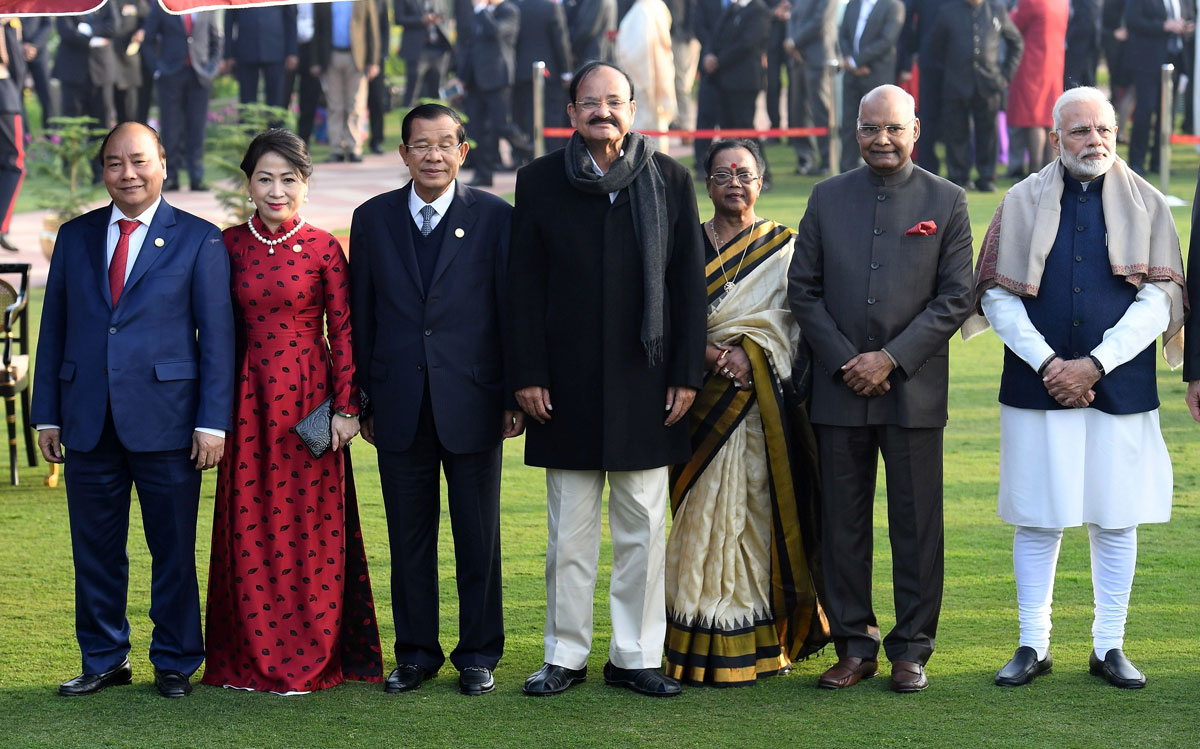Game of Influence: India takes on China
Indian Prime Minister Narendra Modi (r), Indian Vice President Venkaiah Naidu (c) and Indian President Ram Nath Kovind (2nd from r) pose with Cambodian Prime Minister Hun Sen (3rd from l),Vietnamese Prime Minister Nguyen Xuan Phuc (l) after India’s 69th Republic Day Parade in New Delhi, Jan. 26. (Prakash Singh/AFP/Getty Images)
India is always wary about China’s influence in South Asia that in the most literal way has taken the form of executing large infrastructure projects financed via liberal loans and grants. Beijing has focused on constructing ports #oil and gas pipelines and highways that have been areas of considerable expertise of state-backed or private Chinese firms. China’s involvement in Pakistan, for instance, includes the massive $55 billion China-Pakistan Economic Corridor (CPEC), a mega network of roads, rail links, power plants and other infrastructure connecting western Xinjiang province to Pakistan’s southern ports of Gwadar and Karachi, writes Siddharth Srivastava.
As Pakistan meets 75% of its oil needs via imports of crude and refined products, Islamabad has been looking at building downstream assets with the help of willing partner China. These include LNG terminals, pipeline networks and a $4 billion refinery cum petrochemical complex near Karachi.
China is also investing heavily in Bangladesh, Sri Lanka, Nepal and Myanmar. New Delhi has been unhappy about China’s close involvement in building ports in Sri Lanka, that provide strategic access to crucial shipping lanes via the Palk Straits and the waters of the hydrocarbon rich Gulf of Mannar. Despite lacking the vast resources that China possess, India is always on the lookout to extend influence in its neighborhood.
India Exerts Influence
India can only exert limited influence in Pakistan due to troubled relations between the two countries. Efforts, however, are ongoing to engage others in the neighborhood.
In a significant recent move New Delhi has indicated that it may join hands with Russia to expand its presence in the hydrocarbon sector in Vietnam. The indication for trilateral cooperation happened when came Prime Minister Nguyen Xuan Phuc called on President Ram Nath Kovind in Delhi before the Republic Day on Jan. 26.
“We also need to enhance cooperation in the oil and gas sector, including through trilateral cooperation with friendly countries,” read a statement issued. Vietnam enjoys strong military ties with Russia. India, on its part, has plans to sell Brahmos cruise missiles, jointly developed with Russia, to Vietnam. Despite resistance from Beijing, state-owned ONGC, India’s flagship explorer, has deepened its presence in Vietnam’s hydrocarbon sector, including exploring an oil block in South China Sea. China is stridently opposed to India’s oil investments in the South China Sea region.
Closer home, over the recent past, India has also been looking to exploit its enormous refining capacities to produce petrol and diesel to exert influence in the region.
State-owned refiner and fuel retailer Indian Oil Corp (IOC) #that is in the process of opening offices in Bangladesh and Myanmar, is in talks with the two countries to augment trade of petroleum products and offer expertise to set up oil infrastructure, the company chairman Sanjiv Singh has said. IOC plans to offer petrol, diesel from its coastal Paradip refinery in eastern Odisha to Bangladesh and Myanmar. Recently IOC sold spot cargoes of diesel and jet fuel to Myanmar and is looking to strike long-term deals. “Nobody can supply product cheaper to Bangladesh than Paradip,” Singh said.
IOC’s liquefied natural gas (LNG) terminal #which is being built on the eastern coast near Chennai in Tamil Nadu, could also supply neighboring countries that can’t accommodate large ships, Singh said. “This terminal can also provide us opportunity to bring in big ships and probably feed neighboring coastal markets with smaller ships.”
On oil infra, IOC has plans to build refineries, import terminals and retail chains. “Setting up a refinery is a smaller job, the bigger job is to operate and maintain those refineries. These are not capabilities which you buy or create overnight,” Singh said #adding IOC will again participate should Myanmar re-float tender for opening fuel retail stations.
“With these efforts, IOC will be able to substantially scale up its overseas operations in the next five years,” Singh said. IOC already retails fuel in Sri Lanka and Mauritius, deals in lubricants in Dubai and has an operating crude and trading office in Singapore.
IOC is also working on a deal under which Bangladesh will export LPG to some inaccessible north-eastern states. Bangladesh imports all its LPG needs; the plan is to increase imports for supply to north-eastern states. “We are working on concepts that their trucks can come to India and give us LPG. Rather than we trying to feed those parts of north-east #from Haldia (in West Bengal),” Singh said. New Delhi has also been facilitating and encouraging Indian private entities investments in South Asia.
For instance, Anil Ambani promoted Reliance Power is looking to achieve financial closure of the $1 billion 750 MW LNG-fired power plant in Bangladesh by the end of 2017-18. Overall, Reliance Power has signed agreements with Bangladesh Power Development Board to develop 3,000 MW of LNG power units at Meghnaghat near Dhaka and a LNG terminal at Qutubdia Island in Bangladesh. All indications are that The Game of Influence between India and China will only escalate in the future.


